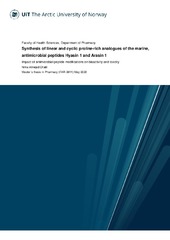| dc.contributor.advisor | Strøm, Morten Bøhmer | |
| dc.contributor.author | Alinejad Chatli, Nima | |
| dc.date.accessioned | 2025-05-13T08:25:46Z | |
| dc.date.available | 2025-05-13T08:25:46Z | |
| dc.date.issued | 2022-05-13 | |
| dc.description.abstract | Since the introduction of antimicrobial agents in the 1940s, antimicrobial resistance has increasingly become a major concern. New resistance mechanisms have emerged and threatened our ability to treat common infections. Currently, antimicrobial resistance is rising to higher levels in all parts of the world and the need of novel therapeutics is increasing. As a contribution to antimicrobial drug discovery, two novel antimicrobial peptides (AMPs) have been isolated from the marine spider crab Hyas Araneus by researchers at UiT the Arctic University of Norway. To evaluate antimicrobial potential and hemolytic activity, various linear and macrocyclic analogues from confined N-terminal sequences of the AMPs Hyasin 1 and Arasin 1 were synthesized. The overall aim of this thesis was to synthesize peptides displaying high antimicrobial activity while preventing toxicity. <p>
<p>In this master project, two novel peptide analogues of Hyasin 1-11 (excluding the control peptide) and five novel analogues of Arasin 1-14 were synthesized using Fmoc-SPPS. A modified pseudo-dilution method was then utilized for head-to-tail macrocyclization of selected peptides. In addition to cyclization, other modifications included alteration of net charge, hydrophobicity and amphiphilicity. All synthesized peptides were purified using RP-HPLC and consecutive purity analyses were conducted on UPLC-PDA. Identification and characterization of the peptides were determined with HR-MS. To evaluate antimicrobial activity, all peptides were screened against selected strains of bacterial and fungal species. Additionally, screening of the peptides against human erythrocytes was conducted for the evaluation of toxicity. <p>
<p>The incorporation of Trp and macrocyclization was the most influential factors in terms of increasing antimicrobial activity with no concurrent toxicity. Macrocyclization of linear precursor peptides with 14 residues were demonstrated with the modified pseudo-dilution method. Highest antimicrobial activity with no concurrent toxicity were detected for the synthesized macrocyclic 14-mer cArasin 1-14 W1,12R5, which rendered it the most promising novel peptide analogue in the present project. | en_US |
| dc.identifier.uri | https://hdl.handle.net/10037/37053 | |
| dc.language.iso | eng | en_US |
| dc.publisher | UiT Norges arktiske universitet | en_US |
| dc.publisher | UiT The Arctic University of Norway | en_US |
| dc.rights.holder | Copyright 2022 The Author(s) | |
| dc.rights.uri | https://creativecommons.org/licenses/by-nc-sa/4.0 | en_US |
| dc.rights | Attribution-NonCommercial-ShareAlike 4.0 International (CC BY-NC-SA 4.0) | en_US |
| dc.subject.courseID | FAR-3911 | |
| dc.subject | VDP::Mathematics and natural science: 400::Chemistry: 440::Pharmaceutical chemistry: 448 | en_US |
| dc.subject | VDP::Matematikk og Naturvitenskap: 400::Kjemi: 440::Legemiddelkjemi: 448 | en_US |
| dc.title | Synthesis of linear and cyclic proline-rich analogues of the marine, antimicrobial peptides Hyasin 1 and Arasin 1. Impact of antimicrobial peptide modifications on bioactivity and toxicity | en_US |
| dc.type | Master thesis | en_US |
| dc.type | Mastergradsoppgave | en_US |


 English
English norsk
norsk
